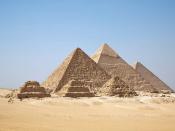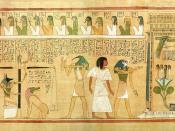There is an old adage that says, "After I am dead, I would have people ask why I have no monument, rather than why I have one."ÃÂ For the Egyptians, there is no such thing. The very ideal of Egyptian life was to attain immortality: physical immortality in the afterlife. This greatest of desires is known to the world today because of the art and literature the ancient Egyptian people left long after the demise of their last pharaoh. It is evident in their pyramids, their murals, and the artifacts left as evidence of their culture and their beliefs.
"Life is the childhood of our immortality."ÃÂ The ancient Egyptians loved life. This is evident in the murals they left on pyramid walls and in shrines throughout their land. Everyday, mundane tasks are portrayed in these lifelike paintings. The occupant of the pyramid would be portrayed eating his favorite foods, working at their job, or playing at their favorite pastime.
It was believed that these paintings would come to life in the afterlife, and remind the soul of what it loved to do. The afterlife was simply a more blissful continuation of life here. Who would not want to live forever? The pyramids are also a prime example of the way in which the Egyptians viewed death. The pyramids were reserved for great people of the times, be it pharaohs, their families, scribes, and advisors. The pyramid's triangular shape was a shrine directed upward, pointing toward the Gods and bringing the occupant closer to them. Within the tomb was a magnificent burial chamber in which was placed, other than the sarcophagus, everything the deceased would need to live a comfortable life in the afterworld. Supplied were the tools of his trade, gold, his amusements, slaves to do his bidding, and even little dolls made in his likeness. These dolls were not simply art, but fill-ins. If, in the afterlife, the soul was called upon to do work, one of the dolls would stand up and take its place. All that was left for the soul to do was play and have fun, enjoying the afterlife as in the finer moments of life.
Of course, no one really feels like that in modern day society. There was never anyone who searched for the Fountain of Youth, or any person that has attempted to find pills and cures to slow aging. And of course, there has never been an attempt to make an exact living, breathing, likeness of oneself (called a clone). Even in today's religious beliefs, it is believed that one's soul will go on to an afterlife, be it heaven or hell, based on one's actions in life. There seems to be a common thread in this quest for immortality throughout antiquity. In all cultures, and especially in modern society, there is almost a fear about death. Some wonder what will come after, and so they search for physical immortality. Although the ancient Egyptians did not seem to fear death, they too sought immortality. They would live on in the afterlife. Today, society searches for a way to live on physically. And for the adherents to various religions, everyone has a belief that they will go on to some eternal place, and they prepare their soul in life, for the journey they will live out after death.
"I don't want to achieve immortality through my work. I want to achieve immortality by living forever."ÃÂ This seems to be the prevalent attitude toward death in any culture, be it ancient Egyptian or today's modern society. Personally, I do not fear death. My own personal beliefs have no set pattern or structure that will aid me in understanding death anymore than any other person before me. I live by my own set of morals, as what I perceive of as a good person. What comes next is not a question I ask myself, but honestly, I don't seek immortality physically. My immortality, I hope, shall be because I made a difference in this world, and changed it for the better. I need no shrine, just a memory.





